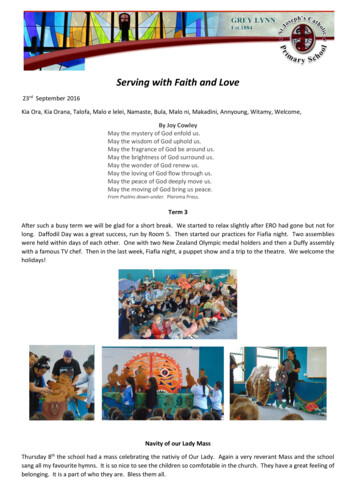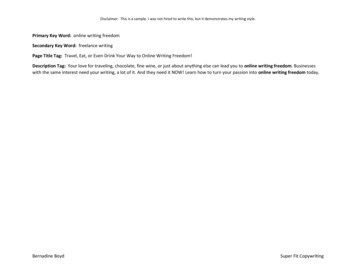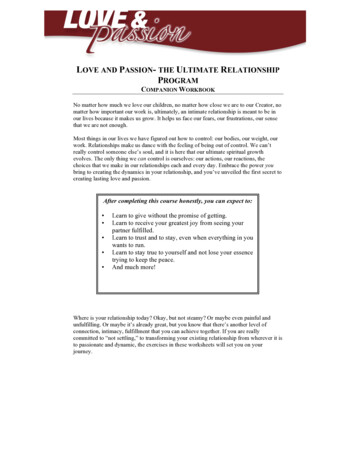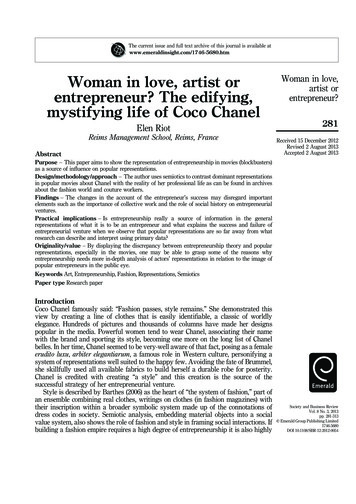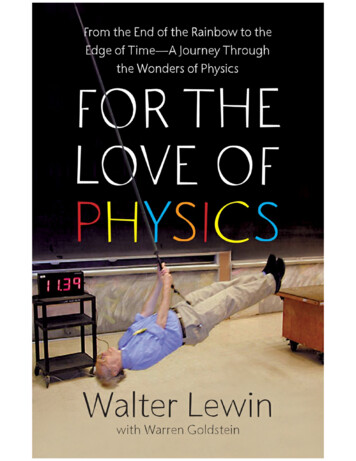
Transcription
Praise forFor the Love of Physics“Fascinating. . . . A delightful scientific memoir combined with a memorable introduction to physics.”—Kirkus Reviews“MIT’s Lewin is deservedly popular for his memorable physics lectures (both live and on MIT’sOpenCourseWare website and YouTube), and this quick-paced autobiography-cum-physics introfully captures his candor and lively teaching style . . . joyful . . . [this text] glows with energy andshould please a wide range of readers.”—Publishers Weekly (starred review)“Lewin may be the only physics professor in the world who celebrates the beauty of Maxwell’sequations for electromagnetic fields by passing out flowers to his delighted students. As the hundredsof thousands of students who have witnessed his lectures in person or online can attest, this classroomwizard transforms textbook formulas into magic. Lewin’s rare creativity shines through . . . a passportto adventure.”—Booklist (starred review)“Of all the souls made famous by YouTube—Justin Bieber, those wedding entrance dancers, that guywho loses his mind while videotaping a double-rainbow—none is more deserving than MIT physicsprofessor Walter Lewin. The professor’s sense of wonder is on full display in a new book: For theLove of Physics: From the End of the Rainbow to the Edge of Time—A Journey Through theWonders of Physics . Why is a rainbow an arc and not a straight line? Why can we typically seeauroras only if we’re close to the North or South Pole? If you’ve ever been interested in learning—or relearning—the answers to these and a hundred other fascinating questions, Lewin’s book is foryou.”—The Boston Globe“Everyone knows that rainbows appear after a storm. But in his new book, Lewin reveals nature’smore unusual rainbows hiding in spray kicked up by ocean waves, in fog swirling around headlights,even in glass particles floating above construction sites. After more than thirty years of teachingundergraduate physics at MIT, Lewin has honed a toolbox of clear, engaging explanations that presentphysics as a way of uncovering the world’s hidden wonders. Quirky, playful, and brimming withearnestness, each chapter is a joyful sketch of a topic—from Newton’s laws to Lewin’s ownpioneering discoveries in X-ray astronomy. Lewin’s creativity offers lessons both for students and foreducators. . . . Throughout it all, his sense of wonder is infectious.”—Science News“Walter Lewin’s unabashed passion for physics shines through on every page of this colorful, largelyautobiographical tour of science. The excitement of discovery is infectious.”—Mario Livio, author of The Golden Ratio and Is God a Mathematician?“In this fun, engaging, and accessible book, Walter Lewin, a superhero of the classroom, uses hispowers for good—ours! The authors share the joy of learning that the world is a knowable place.”—James Kakalios, professor and author of The Physics of Superheroes and The Amazing Story of
Quantum Mechanics
Free PressA Division of Simon & Schuster, Inc. 1230 Avenue of the AmericasNew York, NY 10020www.SimonandSchuster.comCopyright 2011 by Walter Lewin and Warren GoldsteinAll rights reserved, including the right to reproduce this book or portions thereof in any form whatsoever. For information address FreePress Subsidiary Rights Department, 1230 Avenue of the Americas, New York, NY 10020.First Free Press hardcover edition May 2011FREE PRESS and colophon are trademarks of Simon & Schuster, Inc.The Simon & Schuster Speakers Bureau can bring authors to your live event. For more information or to book an event contact theSimon & Schuster Speakers Bureau at 1-866-248-3049 or visit our website at www.simonspeakers.com.Book design by Ellen R. SasaharaManufactured in the United States of America1 3 5 7 9 10 8 6 4 2Library of Congress Cataloging-in-Publication DataLewin, Walter H. G.For the love of physics : from the end of the rainbow to the edge of time—a journey through the wonders of physics / by Walter Lewinwith Warren Goldstein.p. cm.1. Lewin, Walter H. G. 2. Physicists—Massachusetts—Biography. 3. College teachers—Massachusetts—Biography. 4. Physics—Study and teaching—Netherlands. 5. Physics—Study and teaching—Massachusetts. I. Goldstein, Warren Jay. II. Title.QC16.L485A3 2011530.092—dc22[B]2010047737ISBN 978-1-4391-0827-7ISBN 978-1-4391-2354-6 (ebook)
For all who inspired my love for physics and art—Walter lewinFor my grandson Caleb Benjamin Luria—Warren Goldstein
CONTENTSIntroduction1. From the Nucleus to Deep Space2. Measurements, Uncertainties, and the Stars3. Bodies in Motion4. The Magic of Drinking with a Straw5. Over and Under—Outside and Inside—the Rainbow6. The Harmonies of Strings and Winds7. The Wonders of Electricity8. The Mysteries of Magnetism9. Energy Conservation—Plus ça change 10. X-rays from Outer Space!11. X-ray Ballooning, the Early Days12. Cosmic Catastrophes, Neutron Stars, and Black Holes13. Celestial Ballet14. X-ray Bursters!15. Ways of SeeingAcknowledgmentsAppendix 1Appendix 2Index
INTRODUCTIONSix feet two and lean, wearing what looks like a blue work shirt, sleeves rolled to the elbows, khakicargo pants, sandals and white socks, the professor strides back and forth at the front of his lecturehall, declaiming, gesturing, occasionally stopping for emphasis between a long series of blackboardsand a thigh-high lab table. Four hundred chairs slope upward in front of him, occupied by studentswho shift in their seats but keep their eyes glued to their professor, who gives the impression that heis barely containing some powerful energy coursing through his body. With his high forehead, shockof unruly grey hair, glasses, and the trace of some unidentifiable European accent, he gives off a hintof Christopher Lloyd’s Doc Brown in the movie Back to the Future—the intense, otherworldly,slightly mad scientist-inventor.But this is not Doc Brown’s garage—it’s the Massachusetts Institute of Technology, the preeminentscience and engineering university in the United States, perhaps even the world, and lecturing at theblackboard is Professor Walter H. G. Lewin. He halts his stride and turns to the class. “Now. Allimportant in making measurements, which is always ignored in every college physics book”—hethrows his arms wide, fingers spread—“is the uncertainty in your measurements.” He pauses, takes astep, giving them time to consider, and stops again: “Any measurement that you make withoutknowledge of the uncertainty is meaningless.” And the hands fly apart, chopping the air for emphasis.Another pause.“I will repeat this. I want you to hear it tonight at three o’clock in the morning when you wake up.”He is holding both index fingers to his temples, twisting them, pretending to bore into his brain. “Anymeasurement that you make without knowledge of its uncertainty is completely meaningless.” Thestudents stare at him, utterly rapt.We’re just eleven minutes into the first class of Physics 8.01, the most famous introductory collegephysics course in the world.The New York Times ran a front-page piece on Walter Lewin as an MIT “webstar” in December2007, featuring his physics lectures available on the MIT OpenCourseWare site, as well as onYouTube, iTunes U, and Academic Earth. Lewin’s were among the first lectures that MIT posted onthe Internet, and it paid off for MIT. They have been exceptionally popular. The ninety-four lectures—in three full courses, plus seven stand-alones—garner about three thousand viewers per day, amillion hits a year. Those include quite a few visits from none other than Bill Gates, who’s watchedall of courses 8.01, Classical Mechanics, and 8.02, Electricity and Magnetism, according to letters(snail mail!) he’s sent Walter, reporting that he was looking forward to moving on to 8.03, Vibrationsand Waves.“You have changed my life,” runs a common subject line in the emails Lewin receives every dayfrom people of all ages and from all over the world. Steve, a florist from San Diego, wrote, “I walkwith a new spring in my step and I look at life through physics-colored eyes.” Mohamed, anengineering prep school student in Tunisia wrote, “Unfortunately, here in my country my professorsdon’t see any beauty in physics as you do see, and I’ve suffered a lot from this. They just want us tolearn how to solve ‘typical’ exercises to succeed in the exam, they don’t look beyond that tinyhorizon.” Seyed, an Iranian who had already earned a couple of American master’s degrees, writes,“I never really enjoy of life until I have watched you teach physics. Professor Lewin you havechanged my life Indeed. The way you teach it is worth 10 times the tuition, and make SOME not all
other teachers bunch of criminals. It is CAPITAL CRIME to teach bad.” Or Siddharth from India: “Icould feel Physics beyond those equations. Your students will always remember you as I will alwaysremember you—as a very-very fine teacher who made life and learning more interesting than I thoughtwas possible.”Mohamed enthusiastically quotes Lewin’s final lecture in Physics 8.01 with approval: “Perhapsyou will always remember from my lectures that physics can be very exciting and beautiful and it’severywhere around us, all the time, if only you have learned to see it and appreciate its beauty.”Marjory, another fan, wrote, “I watch you as often as I can; sometimes five times per week. I amfascinated by your personality, your sense of humor, and above all by your ability to simplify matters.I hated physics in high school, but you made me love it.”Lewin receives dozens of such emails every week, and he answers each one.Walter Lewin creates magic when he introduces the wonders of physics. What’s his secret? “Iintroduce people to their own world,” he says, “the world they live in and are familiar with, but don’tapproach like a physicist—yet. If I talk about waves on water, I ask them to do certain experiments intheir bathtubs; they can relate to that. They can relate to rainbows. That’s one of the things I loveabout physics: you get to explain anything. And that can be a wonderful experience—for them and forme. I make them love physics! Sometimes, when my students get really engaged, the classes almostfeel like happenings.”He might be perched at the top of a sixteen-foot ladder sucking cranberry juice out of a beaker onthe floor with a long snaking straw made out of lab tubing. Or he could be courting serious injury byputting his head in the path of a small but quite powerful wrecking ball that swings to withinmillimeters of his chin. He might be firing a rifle into two paint cans filled with water, or charginghimself with 300,000 volts of electricity with a large contraption called a Van de Graaff generator—like something out of a mad scientist’s laboratory in a science fiction movie—so that his already wildhair stands straight out from his skull. He uses his body as a piece of experimental equipment. As hesays often, “Science requires sacrifices, after all.” In one demonstration—captured in the photo on thejacket of this book—he sits on an extremely uncomfortable metal ball at the end of a rope suspendedfrom the lecture hall’s ceiling (what he calls the mother of all pendulums) and swings back and forthwhile his students chant the number of swings, all to prove that the number of swings a pendulummakes in any given time is independent of the weight at its end.His son, Emanuel (Chuck) Lewin, has attended some of these lectures and recounts, “I saw himonce inhale helium to change his voice. To get the effect right—the devil is in the details—hetypically gets pretty close to the point of fainting.” An accomplished artist of the blackboard, Lewindraws geometrical figures, vectors, graphs, astronomical phenomena, and animals with abandon. Hismethod of drawing dotted lines so entranced several students that they produced a funny YouTubevideo titled “Some of Walter Lewin’s Best Lines,” consisting simply of lecture excerpts showingLewin drawing his famous dotted lines on different blackboards during his 8.01 lectures. (You canwatch it here: www.youtube.com/watch?v raurl4s0pjU.)A commanding, charismatic presence, Lewin is a genuine eccentric: quirky and physics obsessed.He carries two devices called polarizers in his wallet at all times, so that at a moment’s notice he cansee if any source of light, such as the blue sky, a rainbow, or reflections off windows, is polarized,and whoever he might be with can see it too.What about those blue work shirts he wears to class? Not work shirts at all, it turns out. Lewinorders them, custom made to his specifications, of high-grade cotton, a dozen at a time every fewyears, from a tailor in Hong Kong. The oversize pocket on the left side Lewin designed to
accommodate his calendar. No pocket protectors here—this physicist-performer-teacher is a man ofmeticulous fashion—which makes a person wonder why he appears to be wearing the oddest broochever worn by a university professor: a plastic fried egg. “Better,” he says, “to have egg on my shirtthan on my face.”What is that oversize pink Lucite ring doing on his left hand? And what is that silvery thing pinchinghis shirt right at belly-button level, which he keeps sneaking looks at?Every morning as Lewin dresses, he has the choice of forty rings and thirty-five brooches, as wellas dozens of bracelets and necklaces. His taste runs from the eclectic (Kenyan beaded bracelets, anecklace of large amber pieces, plastic fruit brooches) to the antique (a heavy silver Turkmen cuffbracelet) to designer and artist-created jewelry, to the simply and hilariously outrageous (a necklaceof felt licorice candies). “The students started noticing,” he says, “so I began wearing a differentpiece every lecture. And especially when I give talks to kids. They love it.”And that thing clipped to his shirt that looks like an oversize tie clip? It’s a specially designedwatch (the gift of an artist friend) with the face upside down, so Lewin can look down at his shirt andkeep track of time.It sometim
professor Walter Lewin. The professor’s sense of wonder is on full display in a new book: For the Love of Physics: From the End of the Rainbow to the Edge of Time—A Journey Through the Wonders of Physics. Why is a rainbow an arc and not a straight line? Why can we typically see auroras only if we’re close to the North or South Pole? If you’ve ever been interested in learning— or .

